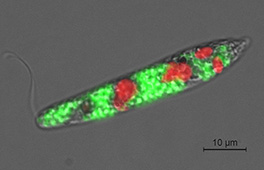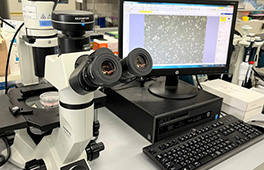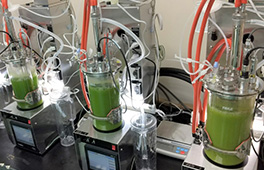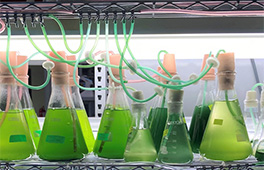※資源サーキュラー技術研究所は、2024年1月に神奈川県横浜市鶴見区へ移転しました。
ページ内掲載内容は佐賀拠点時のものとなります。
Research content
Our institute has (1) an experimental field "Sustainable Tech Farm" that is adjacent to the Saga City Sewage Purification Center, which has the potential as an unused resource, and (2) is capable of agricultural tests that can verify the resource circulation as fertilizer. , ③ It has the feature that it is possible to verify consistent algae production from cultivation, concentration and powdering on a pilot scale. Taking advantage of these characteristics, we are exploring the collection and utilization of unused resources while interacting with the local community, and are conducting research on resource recycling technologies. Through research and development such as technological development to utilize the collected unused resources for algae cultivation and utilization of produced algae biomass as a primary industrial material, we aim to develop a zero-emission type algae production process and create a sustainable resource recycling type industry. It is. Specific tasks include scale-up verification of new materials found to be useful in advanced technology research, early detection and improvement of manufacturing issues for commercial production, and production of prototypes and test samples. I am in charge.

Message from the director

多くの産業において持続可能な発展が求められる時代であり、藻類培養技術はその解決策の一つとして注目を集める技術です。資源サーキュラー技術研究所では社会の未利用資源と当社の持つ藻類培養技術を軸とした複数の先端技術の組み合わせによって、より持続可能な資源循環型の産業創出を目指して研究開発を行っております。当社の掲げる「Sustainability First」を実現するためには、藻類産業の発展に伴って廃棄物・未利用資源が減少し、まずは地域課題が解決されるようなサイクルを作り出すことが必要です。私たちはその実現のため、佐賀の地域社会と関わり合いながら資源循環サイクルのローカルモデルの構築を目指して参ります。
Resource Circular Technology Laboratory
Director Takushi Hanashiro
Research case introduction
Euglena fertilizer development and field testing at sustainable tech farms

The Resources Circular Technology Research Institute is verifying the fertilizer effect when the microalgae Euglena is added to the soil. In fact, we rented agricultural land in Saga City and conducted crop cultivation tests as a sustainable tech farm to verify the effects of Euglena on plants and soil bacteria.
- Research content
-
By beneficially utilizing Euglena, which has not been used in food products, such as Euglena, a microalgae grown from sewage-derived resources to utilize unused resources, and Euglena residue after squeezing oil for biofuel use, waste can be disposed of. We aim to realize a sustainable algae industry and agriculture that does not produce.
Euglena has abundant nutrients, so when used as fertilizer, it can be expected to supply nutrients to plants and soil and to act like plant hormones.
In the field, Euglena powder was mixed into the soil by a cultivator, and a cultivation test of Komatsuna was conducted using ridges with different Euglena contents. Data such as the yield of Japanese mustard spinach, root length, and post-harvest preservation test showed that the weight of edible parts and the ability to maintain freshness were increased in the cultivation of Japanese mustard spinach.
Each measured value for the concentration of Komatsuna and Euglena grown by fertilizing Euglena
未利用資源を用いたバイオマスプラスチック(パラレジン®)の生産

資源サーキュラー技術研究所では、紙ごみや下水資源といった未利用資源を用いて培養した微細藻類ユーグレナから、バイオマスプラスチックを合成する技術の開発を行っています。
当社では、このバイオマスプラスチックをユーグレナに特異的な多糖類であるパラミロンおよびパラレルの「パラ」と英語で樹脂を意味する「レジン」を組み合わせて「パラレジン®」と命名しています。
- Research content
-
微細藻類ユーグレナは特定の条件下において体内にパラミロンという特異的な多糖を貯蔵する性質があります。このパラミロンを用いて化学合成を行うことでバイオマスプラスチックを作ることが可能です。ユーグレナは未利用資源である紙ごみや下水資源を用いて生育することが可能であり、石油由来のプラスチックに比べて資源循環型のプラスチックを作成することができます。
資源サーキュラー技術研究所では、未利用資源使用下においてユーグレナにより多くパラミロンを生産させる条件の検討を行ってきました。ユーグレナの培養からパラレジン®の合成までを小スケールで実証し、より環境にやさしい製造方法を模索することで、サステナブルなバイオマスプラスチック生産を目指しています。




